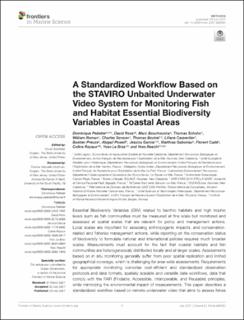| dc.description.abstract | Essential Biodiversity Variables (EBV) related to benthic habitats and high trophic levels such as fish communities must be measured at fine scale but monitored and assessed at spatial scales that are relevant for policy and management actions. Local scales are important for assessing anthropogenic impacts, and conservation-related and fisheries management actions, while reporting on the conservation status of biodiversity to formulate national and international policies requires much broader scales. Measurements must account for the fact that coastal habitats and fish communities are heterogeneously distributed locally and at larger scales. Assessments based on in situ monitoring generally suffer from poor spatial replication and limited geographical coverage, which is challenging for area-wide assessments. Requirements for appropriate monitoring comprise cost-efficient and standardized observation protocols and data formats, spatially scalable and versatile data workflows, data that comply with the FAIR (Findable, Accessible, Interoperable, and Reusable) principles, while minimizing the environmental impact of measurements. This paper describes a standardized workflow based on remote underwater video that aims to assess fishes (at species and community levels) and habitat-related EBVs in coastal areas. This panoramic unbaited video technique was developed in 2007 to survey both fishes and benthic habitats in a cost-efficient manner, and with minimal effect on biodiversity. It can be deployed in areas where low underwater visibility is not a permanent or major limitation. The technique was consolidated and standardized and has been successfully used in varied settings over the last 12 years. We operationalized the EBV workflow by documenting the field protocol, survey design, image post-processing, EBV production and data curation. Applications of the workflow are illustrated here based on some 4,500 observations (fishes and benthic habitats) in the Pacific, Indian and Atlantic Oceans, and Mediterranean Sea. The STAVIRO’s proven track-record of utility and cost-effectiveness indicates that it should be considered by other researchers for future applications. | en_US |
